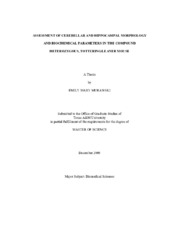| dc.contributor.advisor | Abbott, Louise C. | |
| dc.creator | Murawski, Emily M. | |
| dc.date.accessioned | 2010-07-15T00:15:06Z | |
| dc.date.accessioned | 2010-07-23T21:46:08Z | |
| dc.date.available | 2010-07-15T00:15:06Z | |
| dc.date.available | 2010-07-23T21:46:08Z | |
| dc.date.created | 2009-12 | |
| dc.date.issued | 2010-07-14 | |
| dc.date.submitted | December 2009 | |
| dc.identifier.uri | https://hdl.handle.net/1969.1/ETD-TAMU-2009-12-7380 | |
| dc.description.abstract | Due to two different mutations in the gene that encodes the a1A subunit of
voltage-activated CaV 2.1 calcium ion channels, the compound heterozygous
tottering/leaner (tg/tgla) mouse exhibits numerous neurological deficits. Human
disorders that arise from mutations in this voltage dependent calcium channel are
familial hemiplegic migraine, episodic ataxia-2, and spinocerebellar ataxia 6. The tg/tgla
mouse exhibits ataxia, movement disorders and memory impairment, suggesting that
both the cerebellum and hippocampus are affected. To gain greater understanding of the
many neurological abnormalities that are exhibited by the 90-120 day old tg/tgla mouse
the following aspects were investigated: 1) the morphology of the cerebellum and
hippocampus, 2) proliferation and death in cells of the hippocampal dentate gyrus and 3)
changes in basic biochemical parameters in granule cells of the cerebellum and
hippocampus.
This study revealed no volume abnormalities within the hippocampus of the
mutant mice, but a decrease in cell density with the pyramidal layer of CA3 and the hilus
of the dentate gyrus. Cell size in the CA3 region was unaffected, but cell size in the hilus of the dentate gyrus did not exhibit the gender difference seen in the wild type
mouse. The cerebellum showed a decrease in volume without any decrease in cerebellar
cellular density. Cell proliferation and differentiation in the subgranular zone of the
hippocampal dentate gyrus remained normal. This region also revealed a decrease in
cell death in the tg/tgla mice.
Basal intracellular calcium levels in granule cells show no difference within the
hippocampus, but an increase in the tg/tgla male cerebellum compared to the wild type
male cerebellum. There was no significant difference in granule cell mitochondrial
membrane potential within the wild type and mutant animals in either the hippocampus
or cerebellum. The rate of reactive oxygen species (ROS) production in granule cells
revealed no variation within the hippocampus or cerebellum. The amount of ROS was
decreased in cerebellar granule cells, but not granule cells of the hippocampus. Inducing
ROS showed no alteration in production or amount of ROS produced in the
hippocampus, but did show a ceiling in the amount of ROS produced, but not rate of
production, in the cerebellum. | en |
| dc.format.mimetype | application/pdf | |
| dc.language.iso | eng | |
| dc.subject | Cerebellum | en |
| dc.subject | Hippocampal neurogenesis | en |
| dc.subject | Voltage-gated calcium ion channels | en |
| dc.subject | Mitochondrial membrane potential | en |
| dc.subject | Calcium ion homeostasis, Reactive oxygen species, Compound heterozygous tottering/leaner mouse | en |
| dc.title | Assessment of Cerebellar and Hippocampal Morphology and Biochemical Parameters in the Compound Heterozygous, Tottering/leaner Mouse | en |
| dc.type | Book | en |
| dc.type | Thesis | en |
| thesis.degree.department | Veterinary Integrative Biosciences | en |
| thesis.degree.discipline | Biomedical Sciences | en |
| thesis.degree.grantor | Texas A&M University | en |
| thesis.degree.name | Master of Science | en |
| thesis.degree.level | Masters | en |
| dc.contributor.committeeMember | Welsh, C J. | |
| dc.contributor.committeeMember | Stoica, George | |
| dc.type.genre | Electronic Thesis | en |
| dc.type.material | text | en |


